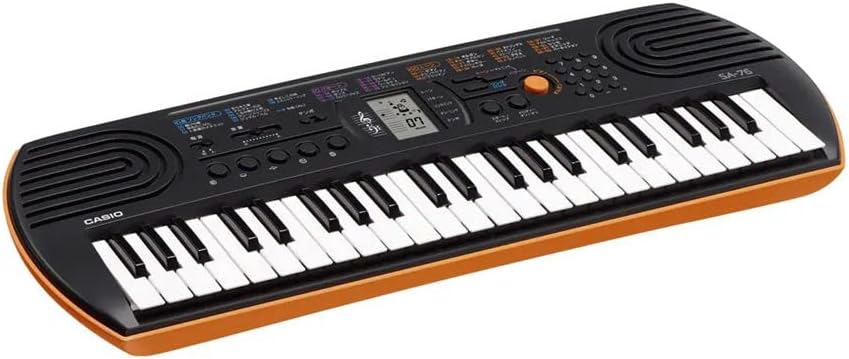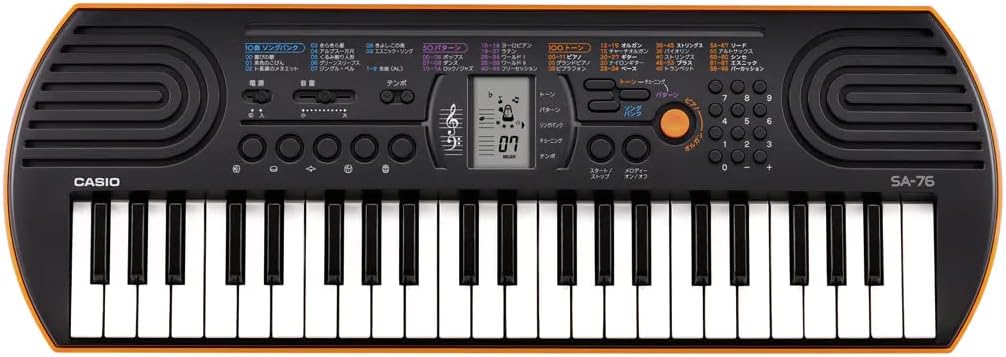INTRODUCTION TO THE CASIO SA-76
How to Play Casio Sa-76 has been a renowned manufacturer of musical instruments for many decades, consistently delivering quality equipment for live performances, studio use, and home practice. Among their impressive lineup, the Casio SA-76 stands out as a portable mini-keyboard packed with exceptional features. In this review, we’ll delve deeper into this keyboard, highlighting its standout features and specifications while also addressing certain limitations.
At first glance, the How to Play Casio Sa-76 boasts a notably compact design, featuring just 44 keys. This compact size offers both advantages and disadvantages. For young aspiring musicians, the small size is a significant benefit, as it allows easy access to all the keys and buttons during play. However, for older players seeking a fuller playing experience, the limited key count may pose a slight drawback. On the positive side, the Casio SA-76 is an excellent choice for older musicians looking for a portable keyboard, as its compact nature ensures easy storage and transport.
Fortunately, the Casio SA-76 compensates for its modest key count with an array of features. The keyboard boasts numerous musical functions, ensuring that your skills are put to good use. This versatility caters to both beginners who are still honing their craft and experienced pianists looking for a range of capabilities to explore.

Layout
One of the notable advantages of a mini-keyboard is its accessibility. Every button, knob, and key is within easy reach, allowing you to effortlessly craft your desired tones.
What sets the How to Play Casio Sa-76 apart is its user-friendly layout, which makes accessing various functions a breeze. Casio has meticulously designed the keyboard to ensure that every key is conveniently positioned for seamless operation. This considerate layout is particularly beneficial for beginners who are still getting the hang of keyboard playing.
At the top of the keyboard, you’ll find shortcut numbers that grant you access to the keyboard’s extensive features. These numbers allow you to explore the keyboard’s 100 different tones, 50 patterns, and 10-song banks. Just below these numbers, there’s a straightforward digital screen. While it may not be flashy or colorful, it serves its purpose well, enabling you to navigate and select various playing options with ease. From this screen, you can delve into song banks, patterns, tone selection, tuning, tempo adjustments, volume control, and even switch between organ and piano tones using the prominent button in the center of the keyboard.
On the left-hand side, positioned just above the keys, you’ll encounter five drum pads. Each of these pads is clearly labeled with distinct symbols representing the sounds they produce. Additionally, several other buttons can be found on this side of the keyboard, including tempo adjustment buttons, a melody on/off button for playing along with different tones, and a start/stop button that gives you control over the preset songs and patterns.

PROS
The Casio SA 76 boasts several key advantages that make it an ideal choice, especially for beginners and young learners:
- Beginner-Friendly: This keyboard is designed with beginners in mind. Its user-friendly layout won’t overwhelm your child with an excessive number of keys, ensuring that learning is not only easy but also enjoyable.
- Compact and Lightweight: The Casio SA 76 is exceptionally compact and lightweight, making it one of the most portable mini-keyboards available. Its portability allows for easy transportation and storage.
- Variety of Voices, Rhythms, and Tunes: Despite its small size, this keyboard provides a decent range of voices, rhythms, and tunes to choose from. It’s also packed with percussion and additional features that will help expand your child’s musical skills and creativity.
- Affordable: The Casio SA 76 is highly affordable, with prices as low as $34. This affordability ensures that in the event of accidental damage, replacing the keyboard won’t be a significant financial burden.
- Tutorial/Demo Tracks: The keyboard comes with tutorial and demo tracks that are easy for young children to master and replicate. These tracks can assist in the learning process.
- Clearly Labeled Functions: All the keyboard’s functions are well labeled, with clear markings that make it easy for users to navigate through the various features. The LCD screen further enhances usability, helping users move seamlessly between functions.
Features
One of the standout features of the How to Play Casio Sa-76 is its 8-note polyphony. While it might seem limited, particularly for a mini-keyboard like the SA-76, the inclusion of this feature is genuinely surprising. The 8-note polyphony allows your children to explore the art of combining different notes to craft captivating melodies. With this polyphony capability, it’s possible to blend up to eight distinct notes simultaneously without any loss in the harmonious blend.
Another noteworthy feature is the headphone jack, which provides a convenient way to create and enjoy music without disturbing those around you. Beginners, especially those learning at home where others may be engaged in different activities, will find this feature invaluable. Even more experienced players who appreciate the simplicity and portability of the Casio SA-76 have expressed their admiration for the headphone jack. They highlight how this feature, when combined with the compact and lightweight design of the keyboard, allows them to continue making music, even on the go, without causing any inconvenience to others.
How to Play Casio Sa-76 also boasts a unique learning tool known as the Melody Cut Rehearsal System. This training program is tailored to assist beginners in mastering keyboard techniques, including finger placement and smooth transitions between keys while maintaining the melody. To facilitate learning, the system can start by training your right hand before progressing to the left hand. Many advanced pianists can attest that they began their journey by learning one hand at a time before advancing further. Therefore, having access to this system can significantly expedite the learning process for both children and adults alike.

CONS
Despite its advantages, the How to Play Casio Sa-76 also comes with certain limitations that potential users should consider:
- Lack of Key Features: This keyboard lacks some essential features commonly found in larger pianos. It does not include functions like transpose, tempo adjustment, tuning control, metronome, dual/layer sound capability, or split keyboard functionality.
- Limited Connectivity: The Casio SA-76 offers minimal connectivity options. It has only a headphone jack, with no provisions for computer connections or USB ports.
- Challenging for Large Hands: Due to its small size, individuals with large hands may find it challenging to play comfortably on this keyboard.
- No Included Power Adapter: The keyboard is not bundled with a power adapter, so users will need to purchase one separately.
- External Durability: The external construction of the Casio SA-76 may not be as robust, which can be a concern, especially when considering its primary user base, which often includes children.
Specs
Here are the key specifications of the Casio SA-76:
- Dimensions: Width: 604mm, Depth: 211mm, Height: 57mm
- Weight: 1.4 kilograms
- Polyphony: 8-note
- Tones: 100
- Song Bank: 10 songs
- Patterns: 50
- Keys: 44 mini-sized keys
- Drum Pads: 5
- Speakers: Two 1.2W speakers
- Headphone Port: Yes
CONCLUSION ON THE CASIO SA 76
How to Play Casio Sa-76 is a straightforward and highly user-friendly keyboard, designed to simplify the learning process. Its compact and portable design allows you to take it with you wherever you go, ensuring constant practice and improvement. With the Melody Cut Rehearsal System and demo tracks, this keyboard serves as an effective learning tool, enabling users to master various keyboard techniques even in the absence of a tutor. While it does have some limitations, the Casio SA-76, priced at under $50, offers excellent value and is highly recommended for beginners, particularly children.

